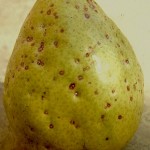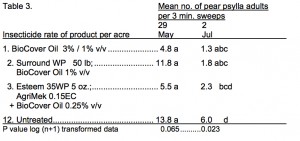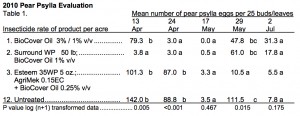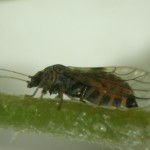
Pears psylla: Mid-Hudson Valley pear blocks we are now at early bud bust in European pear varieties. The egg numbers have increased from 5 eggs from 205 buds on 13 April to 231 eggs in 100 buds in today’s count from our research orchard (Scouting Report).
Our focus over the next three weeks should be to:
* 1st. Delay egg laying (next two weeks)
* 2nd. When the majority of adults have migrated into the orchard, reduce adult psylla populations (late April)
* 3rd. Decrease the viability of the eggs using insect growth regulator (late April)
* 4th. Reduce 1st generation of nymphs (late April – Mid-May)
Over the past week we have seen a moderate increase in pear psylla egg laying with increasing temperatures. Adults will continue to migrate into orchards through April with significant increases in egg production as drier and warmer weather prevails later in the week. Applications to delay oviposition through the use of multiple oil applications (as a 1-2% dilute spray) or the use of Surround WP at 50#/A as a barrier film deterrent (with no toxicant activity) should continue at the next available management window. Egg laying will move from deposits on wood to green tissue as leaves develop after bud burst. This increasing leaf development will produce both seclusion of egg laying sites and increased ‘shadowing’ of the application, making it more difficult to target the eggs. Yet the placement of these products to inhibit significant egg laying will buy you some time to make a targeted adulticide application.
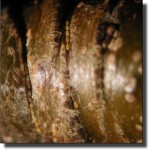
As adult populations continue to move into the orchard, the oil or Surround will reduce the attractiveness of the tree and foliage as egg laying sites. Toward the end of April, adding a select adulticide to the tank would be a sound tactic to target adult psylla before continued egg laying. We have seen the pyrethroids lose their effectiveness to control adults over the past ten years through acquired resistance (detoxification). The pyrethroids, in IRAC Group 3, include Ambush 25WP & Pounce 25WP, both @ 12.8-25.6oz./A, Asana XL 0.66EC @ 9.6-19.12 fl.oz./A, Danitol 2.4EC 16-21.3 fl.oz./A and Warrior II 2.08CS @ 1.28-2.56 fl.oz./A. From work done in 2005 we found the effeciveness of Asana improved against the adult if Piperonyl butoxide (PBO – Incite) was added to the tank mix. PBO inhibits the detoxification mechanism of the pyrethroid by binding to the Cytochrome P450 enzyme receptor sites, preventing the enzymes from detoxifying the pesticide.
With the propensity of pear psylla to develop resistance to insecticides over time, developing a strategy of insecticide resistance management throughout the season, using of a single active ingredient for each of the four generations should be considered now to minimize selection pressure. The robust active ingredient list available for pear psylla management provides a number of labeled materials in no less then 7 modes of action (MOA) groups. Moving away from the pyrethroids makes sense, especially as weather warms and these tools become less effective.
When Psylla nymphs do hatch, they find their way into clusters, well hidden from contact applications and oil applications. However, the neonicintoids have translaminar movement into new tissue to control secluded nymph populations. Of the insecticides in group 4, (Assail, Actara, Provado and Calypso), Actara appears to have excellent efficacy against both adult and nymph populations (Graph 2). Employing oil and the neonicotinoids during the first generation would be one choice in resistance management strategy. Actara does have bee activity and should be halted once white bud develops.
A case for IGR’s: Another choice would include a newer mode of action such as the insect growth regulators. Two labeled products in these groups Centaur WDG (Buprofezin) at 34.5 to 46.0 oz/acre is a is a chitin biosynthesis inhibitors in group groups 16, and Esteem (Pyriproxyfen), at 13-16 oz./A is a juvenile hormone mimic in group 7C. Both of these products can be used with oil. Centaur can be used up to bloom and petal fall with no more then 2 applications per season, providing efficacy against psylla nymphs as they develop (Table 1). These IGR’s also provide efficacy against overwinter immature and crawler stages of scale and mealy bug if they have been a problem in pear the previous year.
The use of Surround and oil are also important tools to reduce egg laying and may reduce the selection pressure for the development of resistance of insecticides used later in the season. A video describing the use of these products can be found here: Pear Psylla – Oil and Surround to reduce egg laying
Apple: We are presently seeing Ginger Gold at 1/2″ green with increasing red banded leaf roller and spotted green fruit worm adult trap captures. No signs of larval presence or feeding thus far on apple.
Applications for San Jose scale control should be underway with insect growth regulators (Centaur & Esteem) being applied at the next available opportunity. The use of Lorsban delayed to the pink stage of apple would optimize obliquebanded leafroller, green fruit worm, red banded leafroller and early plum curculio management.

